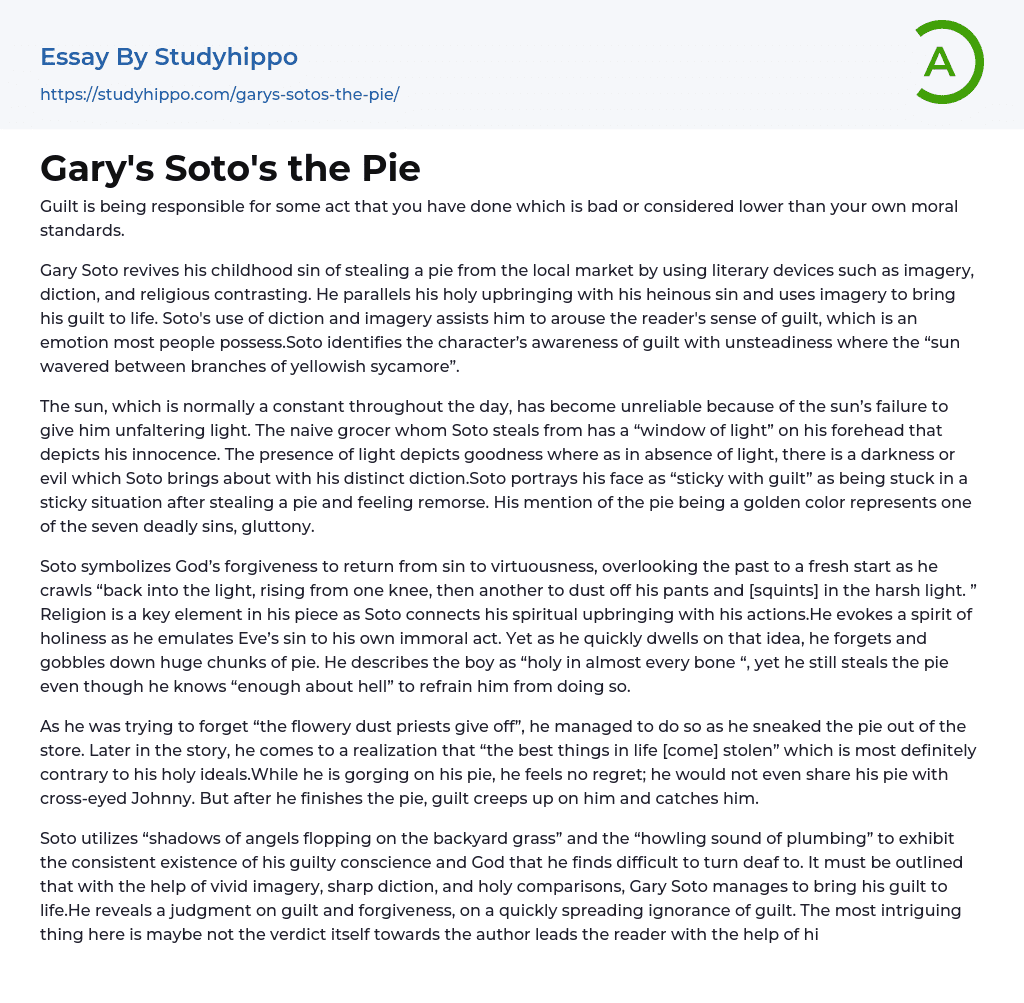Guilt is being responsible for some act that you have done which is bad or considered lower than your own moral standards.
Gary Soto revives his childhood sin of stealing a pie from the local market by using literary devices such as imagery, diction, and religious contrasting. He parallels his holy upbringing with his heinous sin and uses imagery to bring his guilt to life. Soto's use of diction and imagery assists him to arouse the reader's sense of guilt, which is an emotion most people possess.Soto identifies the character’s awareness of guilt with unsteadiness where the “sun wavered between branches of yellowish sycamore”.
The sun, which is normally a constant throughout the day, has become unreliable because of the sun’s failure to give him unfaltering light. The naive grocer whom Soto stea
...ls from has a “window of light” on his forehead that depicts his innocence. The presence of light depicts goodness where as in absence of light, there is a darkness or evil which Soto brings about with his distinct diction.Soto portrays his face as “sticky with guilt” as being stuck in a sticky situation after stealing a pie and feeling remorse. His mention of the pie being a golden color represents one of the seven deadly sins, gluttony.
Soto symbolizes God’s forgiveness to return from sin to virtuousness, overlooking the past to a fresh start as he crawls “back into the light, rising from one knee, then another to dust off his pants and [squints] in the harsh light. ” Religion is a key element in his piece as Soto connects his spiritual upbringing with his actions.He evokes a spirit of holiness as
he emulates Eve’s sin to his own immoral act. Yet as he quickly dwells on that idea, he forgets and gobbles down huge chunks of pie. He describes the boy as “holy in almost every bone “, yet he still steals the pie even though he knows “enough about hell” to refrain him from doing so.
As he was trying to forget “the flowery dust priests give off”, he managed to do so as he sneaked the pie out of the store. Later in the story, he comes to a realization that “the best things in life [come] stolen” which is most definitely contrary to his holy ideals.While he is gorging on his pie, he feels no regret; he would not even share his pie with cross-eyed Johnny. But after he finishes the pie, guilt creeps up on him and catches him.
Soto utilizes “shadows of angels flopping on the backyard grass” and the “howling sound of plumbing” to exhibit the consistent existence of his guilty conscience and God that he finds difficult to turn deaf to. It must be outlined that with the help of vivid imagery, sharp diction, and holy comparisons, Gary Soto manages to bring his guilt to life.He reveals a judgment on guilt and forgiveness, on a quickly spreading ignorance of guilt. The most intriguing thing here is maybe not the verdict itself towards the author leads the reader with the help of his contrasts and diction, but its basic influence on guilt, which is perhaps, the key aim of the author’s message. Perhaps you too can relate since Soto’s language expresses imagery indicative of a guilty conscience with the “juice
of guilt wetting [his] underarms.
”
- Adoption essays
- Aunt essays
- Babies essays
- Bedroom essays
- Caring essays
- Children essays
- Daughter essays
- Divorce essays
- Dog essays
- Dysfunctional Family essays
- Family Tradition essays
- Family Values essays
- Father essays
- Foster Care essays
- Friends essays
- Grandparent essays
- Home essays
- Hometown essays
- Husband essays
- Jealousy essays
- Love essays
- Marriage essays
- Mother essays
- Online Dating essays
- Parenting essays
- Parenting Teens essays
- Parents essays
- Relationship essays
- Room essays
- Sibling essays
- Sister essays
- Wedding essays
- Wife essays
- Adult essays
- Aggression essays
- Altruism essays
- Archetype essays
- Behavior essays
- Certainty essays
- Conformity essays
- Deception essays
- Human Behavior essays
- Human Sexuality essays
- Maturity essays
- Morality essays
- Obedience essays
- Procrastination essays
- Reinforcement essays
- Role Model essays
- Afterlife essays




